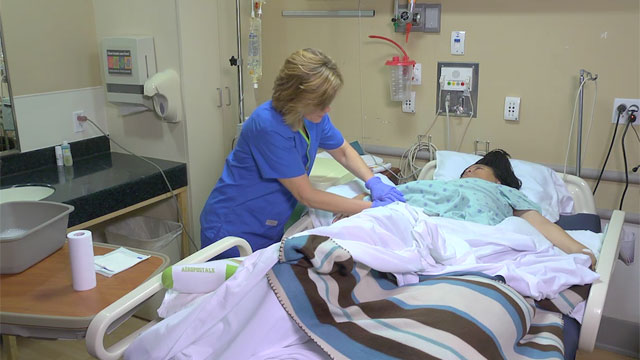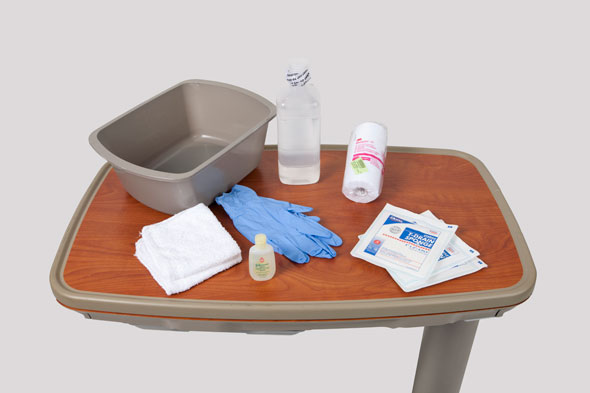Urinary Catheter Management
Select a Skill:
- » Inserting an Indwelling Urinary Catheter in a Female Patient
- » Inserting an Indwelling Urinary Catheter in a Male Patient
- » Irrigating a Urinary Catheter
- » Performing Intermittent Straight Catheterization
- » Obtaining a Specimen from an Indwelling Urinary Catheter
- » Removing an Indwelling Urinary Catheter
- » Caring for a Suprapubic Catheter
Take the Review Test:

Safety
- Be sure to assess the patient for allergies, such as sensitivity to tape, latex, or antiseptic solution.
- Monitor for complications, such as urinary tract infection (UTI), skin site infection, decreased urinary output, and catheter occlusion.
- Observe the catheter insertion site for erythema, edema, discharge, and tenderness. Check the dressing at least every 8 hours.
- Avoid placing tension on the catheter, since doing so may be uncomfortable for the patient and can damage the bladder wall or dislodge the catheter.
- Keep the drainage bag below the level of the bladder.
Equipment
(Roll cursor over items to see labels)

Clean gloves
Sterile normal saline solution
Sterile surgical drainage sponge
Sterile gauze dressing
Washcloth and towel
Soap
Basin
Metapore Tape
Delegation
The skill of caring for a newly established suprapubic catheter cannot be delegated to nursing assistive personnel (NAP); however, care of an established suprapubic catheter may be delegated. Refer to your agency’s policy for the role of NAP in caring for a patient with a suprapubic catheter. Be sure to inform NAP of the following:
- Instruct NAP to report to you if the patient has any discomfort related to the suprapubic catheter.
- Review the schedule for emptying the drainage bag and the procedure for documenting the urinary output on the I&O record.
- Instruct NAP to report to you any change in the amount or character of the urine.
Instruct NAP to report to you any sign of redness, foul odor, or drainage around the catheter insertion site.
Preparation
- Assess the urine in the drainage bag for amount, clarity, color, odor, and sediment.
- Observe the dressing for drainage and intactness.
- Assess the catheter insertion site for the growth of over-granulation tissue and for signs of inflammation: pain, erythema, edema, and drainage. Ask the patient if there is any pain at the site; if so, ask the patient to rate the pain on a scale of 0 to 10.
- Assess the patient for elevated temperature and chills.
- Assess the patient’s knowledge of the purpose for the catheter and its care.
- Check for any patient allergies.
Follow-up
- Ask the patient to rate any pain or discomfort from the suprapubic catheter on a scale of 0 to 10.
- Monitor for signs of infection, such as fever or an elevated white blood count, and observe the urine for clarity, sediment, and unusual color or odor.
- Observe the catheter insertion site for erythema, edema, discharge, or tenderness. Check the dressing at least every 8 hours.
Documentation
- Record and report the character of the urine, the type of dressing change, including assessments of the insertion site and the patient’s comfort level with the catheter and dressing change.
- Record the patient’s urine output on the I&O flow sheet. If the patient has both suprapubic and urethral catheters, record each output separately.
Review Questions
1. A patient with a suprapubic catheter is complaining of pain. What will the nurse do first to help this patient?
 Ensure that the patient is not lying on the drainage tubing
Ensure that the patient is not lying on the drainage tubing  Instruct the patient to increase his or her oral fluid intake
Instruct the patient to increase his or her oral fluid intake  Observe the rate of drainage in the urine collection bag
Observe the rate of drainage in the urine collection bag  Notify the health care provider
Notify the health care provider
2. What is the primary reason the nurse applies sterile gloves rather than clean ones when caring for a patient with a newly inserted suprapubic catheter?
 To protect the nurse and other patients from pathogens
To protect the nurse and other patients from pathogens To collect a sterile urine sample
To collect a sterile urine sample  To reduce the patient's risk of infection
To reduce the patient's risk of infection  To reduce the patient’s risk of injury
To reduce the patient’s risk of injury
3. Which statement might the nurse make to nursing assistive personnel (NAP) assigned to care for a patient with an established suprapubic catheter?
 "Tell me if the catheter site looks inflamed."
"Tell me if the catheter site looks inflamed."  "I need to know the patient's temperature each time it's taken."
"I need to know the patient's temperature each time it's taken."  "Wear sterile treatment gloves when you remove the dressing."
"Wear sterile treatment gloves when you remove the dressing."  "Let me know if the patient's catheter is infected"
"Let me know if the patient's catheter is infected"
4. Which nursing action reduces the risk of injury in a patient with a suprapubic catheter?
 Applying sterile gloves before cleaning the catheter insertion site
Applying sterile gloves before cleaning the catheter insertion site  Cleansing the skin surrounding the insertion site
Cleansing the skin surrounding the insertion site  Securing the catheter to the abdomen
Securing the catheter to the abdomen  Keeping the drainage bag above the level of the patient's bladder
Keeping the drainage bag above the level of the patient's bladder
5. A newly inserted suprapubic catheter becomes dislodged. What action should the nurse perform first?
 Notify the health care provider
Notify the health care provider  Apply pressure over the site
Apply pressure over the site  Cover the site with a sterile dressing
Cover the site with a sterile dressing  Help the patient into a side-lying position
Help the patient into a side-lying position
You have completed the Review Questions for this skill. To take the Review again select the Start Over button. To proceed to another skill select from the dropdown menu. Select the Home or Back button to proceed to the next section.

